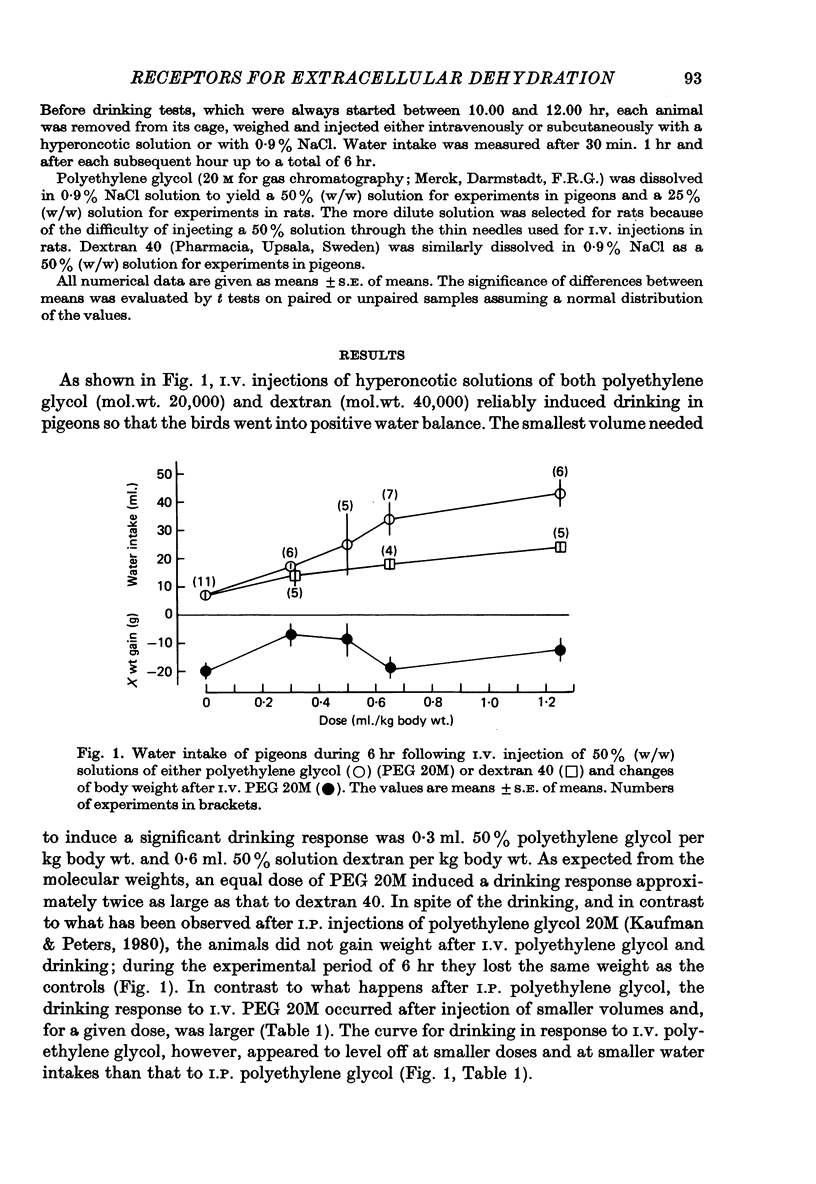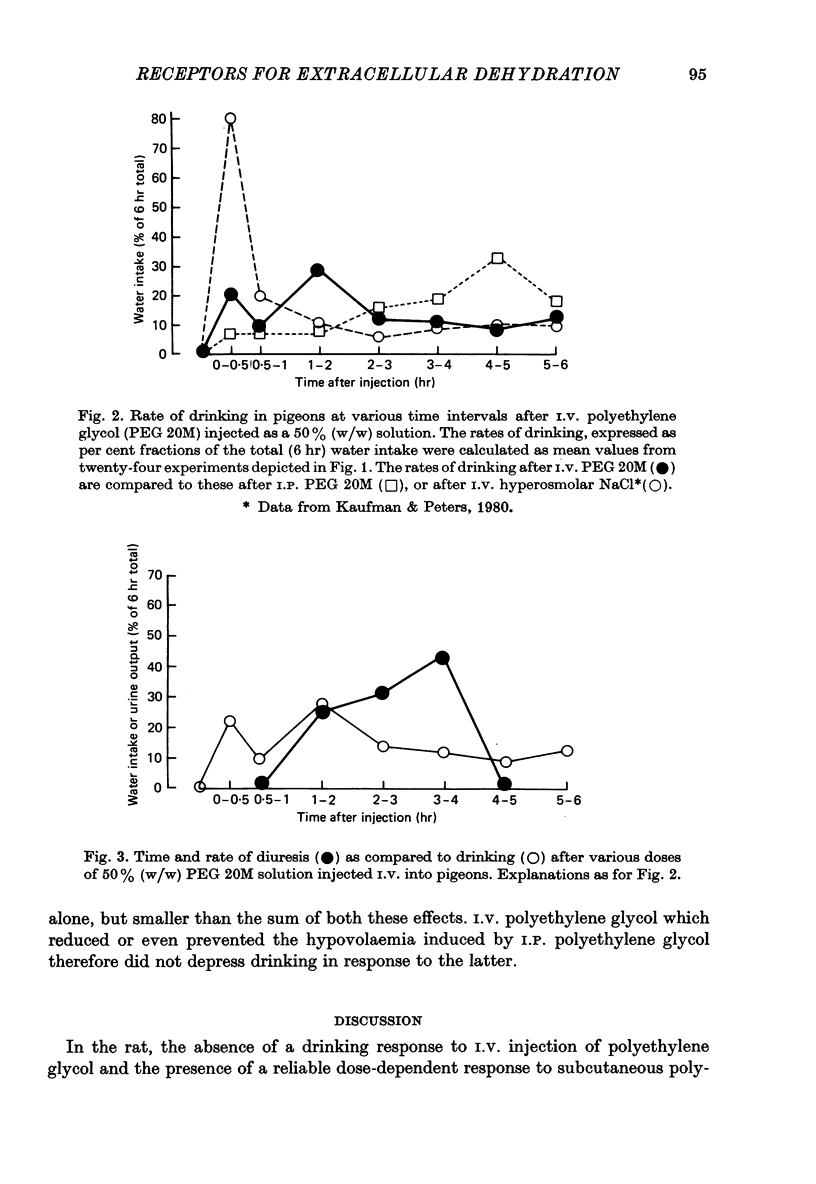Abstract
1. In pigeons, the I.V. injection of 0·3-1·3 ml. of 50% (w/w) solutions of either polyethylene glycol (mol.wt. 20,000) or dextran (mol.wt. 40,000) induced reliable, rapid dose-dependent drinking responses. The amount of water drunk in response to I.V. polyethylene glycol was greater than that in response to I.P. polyethylene glycol and twice that in response to I.V. dextran. I.V. polyethylene glycol induced a diuresis following the onset of drinking.
2. The dipsogenic effect of I.P. polyethylene glycol solutions in the pigeon was depressed by I.V. isotonic NaCl solution 1 hr before offering water but was increased by simultaneous I.V. hyperoncotic polyethylene glycol solution.
3. In contrast, in rats, the subcutaneous injection of 25% (w/w) polyethylene glycol (mol.wt. 20,000; 1·25-10·0 ml./kg body wt.) induced reliable drinking responses, while the same doses of polyethylene glycol, injected I.V., did not induce drinking consistently. The volume of water drunk by rats in response to subcutaneous polyethylene glycol was smaller per unit dose than that drunk by I.P. injected pigeons.
4. The results suggest that receptors for drinking induced by extracellular dehydration in the pigeon could be situated in the extravascular interstitial section of the extracellular compartment.
Full text
PDF








Selected References
These references are in PubMed. This may not be the complete list of references from this article.
- Anderson R. E., Warne P. J., West G. B. Carrageenan and dextran in rats. Int Arch Allergy Appl Immunol. 1976;52(1-4):425–427. doi: 10.1159/000231712. [DOI] [PubMed] [Google Scholar]
- Bonjour J. P., Peters G. Non-occurrence of a natriuretic factor in circulating blood of rats after expansion of the extracellular or the intravascular space. Pflugers Arch. 1970;318(1):21–34. doi: 10.1007/BF00588540. [DOI] [PubMed] [Google Scholar]
- Fitzsimons J. T., Kaufman S. Cellular and extracellular dehydration, and angiotensin as stimuli to drinking in the common iguana Iguana iguana. J Physiol. 1977 Feb;265(2):443–463. doi: 10.1113/jphysiol.1977.sp011724. [DOI] [PMC free article] [PubMed] [Google Scholar]
- GAUER O. H., HENRY J. P. Circulatory basis of fluid volume control. Physiol Rev. 1963 Jul;43:423–481. doi: 10.1152/physrev.1963.43.3.423. [DOI] [PubMed] [Google Scholar]
- GILMORE J. P., WEISFELDT M. L. CONTRIBUTION OF INTRAVASCULAR RECEPTORS TO THE RENAL RESPONSES FOLLOWING INTRAVASCULAR VOLUME EXPANSION. Circ Res. 1965 Aug;17:144–154. doi: 10.1161/01.res.17.2.144. [DOI] [PubMed] [Google Scholar]
- Hall J. E., Guyton A. C. Changes in renal hemodynamics and renin release caused by increased plasma oncotic pressure. Am J Physiol. 1976 Nov;231(5 Pt 1):1550–1556. doi: 10.1152/ajplegacy.1976.231.5.1550. [DOI] [PubMed] [Google Scholar]
- Knox F. G., Schneider E. G., Dresser T. P., Lynch R. E. Natriuretic effect of increased proximal delivery in dogs with salt retention. Am J Physiol. 1970 Oct;219(4):904–910. doi: 10.1152/ajplegacy.1970.219.4.904. [DOI] [PubMed] [Google Scholar]
- Lichardus B., Pearce J. W. Evidence for a humoral natriuretic factor released by blood volume expansion. Nature. 1966 Jan 22;209(5021):407–409. doi: 10.1038/209407a0. [DOI] [PubMed] [Google Scholar]
- MORRISON J. L., RICHARDSON A. P., BLOOM W. L. The effects of antihistaminic agents on the reaction of the rat to dextran. Arch Int Pharmacodyn Ther. 1951 Oct;88(1):98–105. [PubMed] [Google Scholar]
- Pearce J. W. The renal response to volume expansion. Can J Physiol Pharmacol. 1968 Mar;46(2):305–313. doi: 10.1139/y68-050. [DOI] [PubMed] [Google Scholar]
- Stricker E. M. Extracellular fluid volume and thirst. Am J Physiol. 1966 Jul;211(1):232–238. doi: 10.1152/ajplegacy.1966.211.1.232. [DOI] [PubMed] [Google Scholar]


